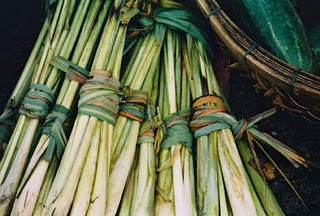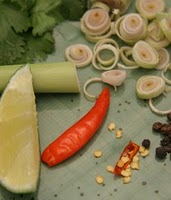
This
is my confession: I lived in Southeast Asia for four years and didn’t
learn how to cook a single dish. It was not until I returned to America,
leaving behind corner stalls and their 25¢ meals, that I took on the
cuisine in my own kitchen. Feeling the need to start with something
simple, I announced to my friends that I was going to make
tom kha gai,
and everyone should drop by on Sunday night to marvel at my epicurean
skills. I looked up a recipe for the popular Thai chicken-coconut soup
online; gathered the garlic, ginger, and turmeric; and chopped and
simmered according to the directions. Not only was it bad
tom kha gai, it was bad soup. Some of the worst soup my not-so-diplomatic friends had eaten.
I
was sad. I spent years in the tropics nurturing a love for the region’s
complex fusion of salty, sour, hot, and sweet. The grit of ground rice
powder, and the tang of lime. How could I have failed? As if I had been
challenged, I started Googling, downloading recipe after recipe for tom
kha gai, laying them out side by side on my kitchen counter, studying
them in search of my Rosetta Stone.
Why did none of these new
recipes mention turmeric? Why did some call for ginger and others for
galangal? Maybe my failure was due to the kaffir lime leaves I wasn’t
able to find. But could a leaf really make that much difference?
Armed
with a recipe I cobbled together from my research, I accepted that my
local Ralphs and Gelson’s grocery stores weren’t up to this project, and
started investigating alternative markets. In a copy of Los Angeles Marketplace,
I happened upon a recommendation for the Bangkok Supermarket on Melrose
Avenue. Just past Western, it is a smog-stained white building topped
by a nondescript sign that blends into the L.A. haze. It has an
unimpressive, miniscule, door-ding parking lot, but the moment I stepped
inside, I knew I’d found the pungent keeper of the secrets to tom kha gai.
Along
with banana leaves, clay cooking pots for less than ten dollars, and
the fleshy sweetsop fruit I thought I’d never taste outside Asia, I
found kaffir lime leaves. A whole bundle for $1.19. And on the floor
beneath them: a cardboard box filled with lemongrass at 39¢ a pound.
Aisle B yielded half a dozen brands of nam prik pao. Who knew there were
so many options when it came to chili paste?
I gathered excess
amounts of everything I needed and headed back home. During the next
month, fortified by visits to the Bangkok Market, I experimented. I
discovered the necessity of the individual ingredients, their
complements and contrasts, and why ginger is not galangal. Its spiciness
lacks nerve. Ginger nips, but galangal bites. Those who think the fire
in tom kha gai comes solely from its chilies are mistaken. It is chili
combined with the slices of galangal that bring out the soup’s
distinctive heat.
The kaffir lime leaves also work with their
accompanying ingredients, providing a sherbet blend of citrus and cream.
Tom kha gai may seem to derive its creaminess from coconut milk, but it
is in fact the union of this milk with the leaves that give it its
buttery undertone. The third essential fusion is lime and lemongrass.
Both lend the soup a refreshing quality. But while lime provides tang,
lemongrass counters with a soothing balm. Its fragrance reminds me of
the subtle relief that nightfall eases through Southeast Asian cities.
The
soup’s citrus, spice, cream, and heat require a final ingredient for
balance: salt. But tom kha gai does not call for even a dash. Instead,
it wants fish sauce, and when it comes to this stinky component, less is
more. If you ever wonder if just one tablespoon is stingy, keep this in
mind: It isn’t, and it never will be. One reeking pot of soup I made,
which included a quarter cup, can attest to this. The Bangkok Market
offers many kinds of fish sauce, and I recommend the Three Crabs brand.
It
took me a few months to produce a tom kha gai that satisfied me like
the soup I’d often had in Thailand. This is a long time to master just
one dish, but I believed that it was worth it. So I returned to the
Bangkok Market with my second recipe, for Laotian laap, and I calculated
that at the rate I was going, I’d be ready in a year or two to throw a
Southeast Asian dinner party.
 Tom Kha Gai
Tom Kha Gai
Ingredients:- 8 kaffir lime leaves
- 3 cans unsweetened coconut milk (Chaokoh brand)
- 1 can chicken broth
- 6 fresh galangal slices, about 1 inch in diameter
- 4 lemongrass stalks, lower third only, cut into 2-inch lengths and crushed (see following note)
- 4 fresh small green chili peppers, halved
- 1 Tbsp. Thai roasted chili paste (nam prik pao)
- 1 whole boneless chicken breast, cut into small slices or cubes
- 1 can drained, canned whole straw mushrooms
- ½ cup drained, canned sliced bamboo shoots
- ¼ cup fresh lime juice
- ¼ cup fresh cilantro leaves
- 1 Tbsp. fish sauce (nam pla)
Directions:1)
Place 4 of the kaffir leaves in a large saucepan. Add the coconut milk,
chicken broth, galangal, lemongrass and chilies. Bring to a boil, then
reduce heat to low and simmer for 20 minutes.
2) Strain out and discard all pieces. Bring the strained liquid to a boil. Reduce heat to medium to that it boils gently.
3) Add remaining 4 kaffir leaves, roasted chili paste, chicken, mushrooms, bamboo shoots, and fish sauce.
4) Boil gently until the chicken is cooked throughout, about three minutes.
5) Stir in lime juice and cilantro leaves.
Working with lemongrass:
Cut
off the root tip, and then cut a two-inch piece (approximately
one-third of the stalk) from this end. Peel off the outer layer. The
inner piece is what you’ll work with. It can be sliced thin and tossed
in marinades, or crushed with the flat of your knife to bring out the
oil. You can also drop the crushed pieces with 2 sprigs of mint into a
glass of iced tea, or alone into a cup of hot water to help you sleep.
SERVE IT FORTH: INDEX OF RECIPES
Bangkok Supermarket
4757 Melrose Ave.
Los Angeles, California
This essay was originally written for a food writing class and published on La Lunchbox.
 At the end of last year, Chez Pim
organized the second annual Menu for Hope, a global raffle to raise
money for the United Nations World Food Program. Food bloggers and
generous foodies around the planet offered up mouthwatering prizes, and I
was the lucky winner of three gorgeous jars of honey and a gooey
honeycomb from Malfroy's Gold in Australia. This honey is made from eucalyptus and has a distinctive caramel flavor. In one word: addictive.
At the end of last year, Chez Pim
organized the second annual Menu for Hope, a global raffle to raise
money for the United Nations World Food Program. Food bloggers and
generous foodies around the planet offered up mouthwatering prizes, and I
was the lucky winner of three gorgeous jars of honey and a gooey
honeycomb from Malfroy's Gold in Australia. This honey is made from eucalyptus and has a distinctive caramel flavor. In one word: addictive. Malfroy's Gold Website
Malfroy's Gold Website Pasolivo Website
Pasolivo Website







